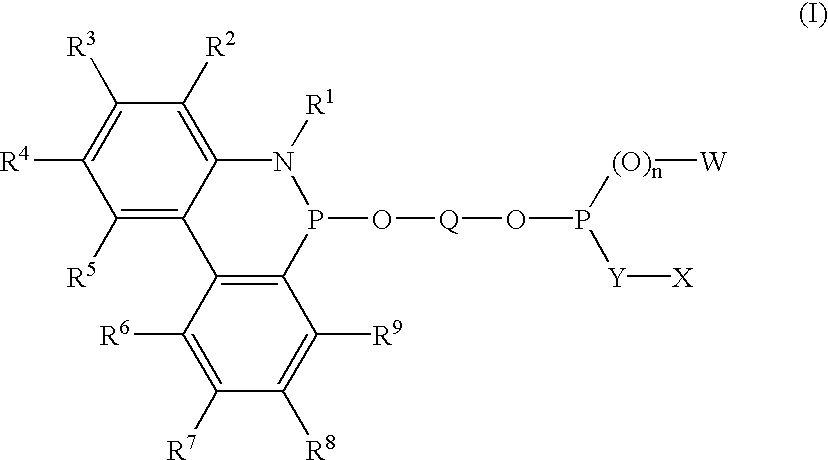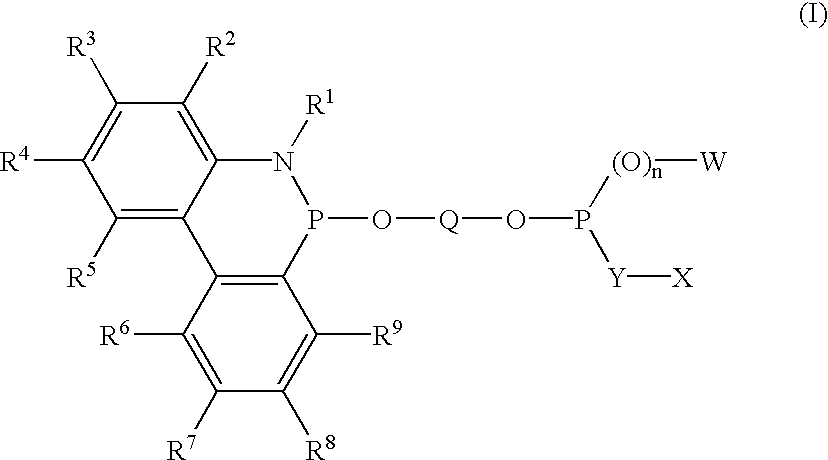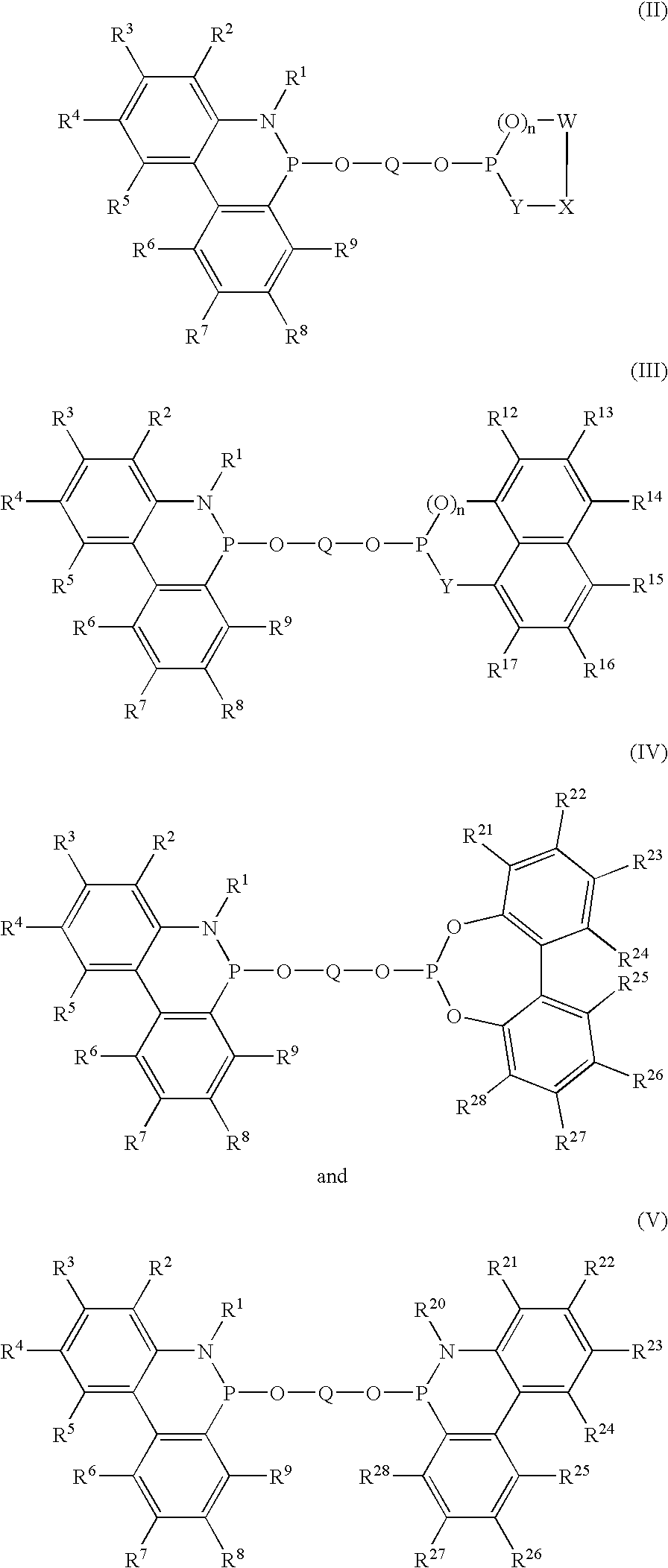Phosphinine compounds and metal complexes thereof
a technology of phosphine compounds and metal complexes, which is applied in the direction of organic compounds/hydrides/coordination complexes, physical/chemical process catalysts, ruthenium organic compounds, etc., can solve the problems of low selectivity to terminally hydroformylated compounds, relatively high preparation cost of phosphine ligands, and ineconomically viable industrial processes to use such systems
- Summary
- Abstract
- Description
- Claims
- Application Information
AI Technical Summary
Problems solved by technology
Method used
Image
Examples
example 1
##STR12##
a) 2-Ethoxycarbonylaminobiphenyl
A solution of 21.7 g (0.2 mol) of ethyl chloroformate in 20 ml of dichloromethane is slowly added dropwise to a mixture of 25 g of 2-aminobiphenyl (0.148 mol) and 79 g of pyridine (1 mol) in 150 ml of dichloromethane while stirring. After stirring for 12 hours, 100 ml of 10% strength NaOH are added. The aqueous phase is separated off and shaken with dichloromethane. After the dichloromethane extract has been dried over sodium sulfate, the solvent is removed under reduced pressure and the red oil which remains is worked up by column chromatography (silica gel 60, 0.043 . . . 0.060 mm, eluant: hexane / ethyl acetate=9:1). Yield: 31.7 g=89%.
b) N-Methyl-o-phenylaniline
A solution of 18 g (0.075 mol) of 2-ethoxycarbonylaminobiphenyl in 100 ml of THF is added dropwise to a suspension of 14.2 g (0.373 mol) of lithium aluminum hydride in 300 ml of THF. The mixture is stirred for another 1 hour and then refluxed for 3 hours. Subsequently, while cooling i...
example 2
##STR13##
Intermediate B
A solution of 0.93 g of PCl.sub.3 (6.75 mmol) in 10 ml of THF is added dropwise at 0.degree. C. to a solution of 2.42 g of 2,2'-bis(6-tert-butyl-1-hydroxy-4-methoxyphenyl) (6.75 mmol) and 1.6 ml of pyridine in 22 ml of THF. After stirring for 4 hours at 25.degree. C., the solvent is removed under reduced pressure. After addition of 40 ml of diethyl ether, filtration and evaporation under reduced pressure, 2.8 g (98%) of spectroscopically pure chlorophosphorous ester of 2,2'-bis(6-tert-butyl-1-hydroxy-4-methoxyphenyl) are obtained: .sup.31 P-NMR (CD.sub.2 Cl.sub.2) .delta. 172.7 ppm. 2.8 g of this chloroester (6.62 mmol) in 20 ml of THF are added at room temperature to a monolithium phenoxide solution obtained at -20.degree. C. from 2.37 g of 2,2'-bis(6-tert-butyl-1-hydroxy-4-methoxyphenyl) (6.62 mmol) in 30 ml of THF and 20.7 ml of a 0.32 M n-butyllithium solution in hexane (6.62 mmol). After 24 hours, the mixture is evaporated under reduced pressure. Addition...
example 3
Synthesis of a Phosphinine of the Formula 1-c
One equivalent of n-butyllithium dissolved in 13 ml of hexane is added dropwise at -20.degree. C. to 3.06 g of intermediate B from Example 2 (4.11 mmol) in 32 ml of THF while stirring. After warning to room temperature and stirring for 30 minutes, the solution obtained is added to 0.961 g of 10-chloro-9,10-dihydro-9-aza-10-phosphaphenanthrene (intermediate C-2 from Example 4) (4.11 mmol) dissolved in 7 ml of THF and the mixture is stirred at room temperature for 4 hours. The residue obtained after taking off the solvent mixture under reduced pressure is triturated in 80 ml of hexane. The mixture is filtered and the residue on the frit is extracted by distillation 5 times from the mother liquor. Evaporation of the solution to 50% of its original volume and storage at -28.degree. C. for 3 days gives the crude product, which is recrystallized once more from hot hexane. Yield; 1.9 g=48%.
Analysis (calculated for C.sub.56 H.sub.65 O.sub.8 P.sub...
PUM
| Property | Measurement | Unit |
|---|---|---|
| pressures | aaaaa | aaaaa |
| pressures | aaaaa | aaaaa |
| temperatures | aaaaa | aaaaa |
Abstract
Description
Claims
Application Information
 Login to View More
Login to View More - R&D
- Intellectual Property
- Life Sciences
- Materials
- Tech Scout
- Unparalleled Data Quality
- Higher Quality Content
- 60% Fewer Hallucinations
Browse by: Latest US Patents, China's latest patents, Technical Efficacy Thesaurus, Application Domain, Technology Topic, Popular Technical Reports.
© 2025 PatSnap. All rights reserved.Legal|Privacy policy|Modern Slavery Act Transparency Statement|Sitemap|About US| Contact US: help@patsnap.com



